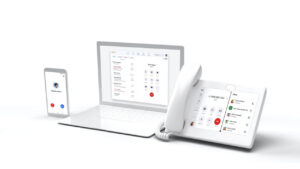Transforming Communication: The Zoom Phone Project at Stevens Institute of Technology
With the goal of modernizing campus communication infrastructure, Stevens Institute of Technology recently transitioned from their traditional phone systems to the innovative Zoom Phone service. This ambitious IT project involved detailed planning, procurement, and deployment to ensure seamless implementation across all departments. The successful migration of the institution’s phone systems not only transformed communication, but also delivered significant cost savings, improved emergency services, and set the stage for future innovation.
Legacy System Challenges
As Stevens Institute of Technology sought to modernize its communication infrastructure, the limitations of its legacy systems became increasingly apparent, prompting the need for a more effective solution. "We decided to move forward with Zoom because our legacy Cisco hardware was not only at the end of its life, but also painful to manage,” explains Hammad Ali, Senior Director of Infrastructure Services, Stevens Institute of Technology. “We lacked the resources to maintain it, relying heavily on third parties. When COVID hit, it became clear that we needed to transition to cloud-based solutions, as the Cisco system couldn't provide the remote capabilities we required. This led to a fragmented environment with multiple systems like Microsoft Teams, Zoom, Slack, and RingCentral, which created inefficiencies. Additionally, our existing system didn’t meet compliance requirements, and the disaster recovery options were limited."
At the onset of the project, Stevens identified several objectives and what they wanted to accomplish moving forward. “We wanted the new system to be fully cloud-based, ensuring seamless remote access and minimal dependency on on-prem infrastructure,” says Ali. “The system needed to integrate smoothly with the institution’s core IT technologies and prioritize ease of use, particularly in moving away from physical phones in favor of softphones. We also needed robust emergency phone services to support campus security, along with effective contact center capabilities.”
After reviewing several options, the team narrowed it down to two major platforms: Microsoft Teams and Zoom. While Teams was already widely used across administrative offices, Zoom had gained significant traction, particularly among faculty. “Our faculty loved Zoom, and its adoption was widespread across the institution,” says Ali. “Given its ease of use, comprehensive features, and full integration with existing systems, Zoom emerged as the clear choice. Unlike Teams, which lacked a fully integrated contact center solution and robust emergency phone features at the time, Zoom provided a complete package that met all their needs, making it the simplest and most reliable option for the project.”
The next crucial step was selecting the right partner. The team quickly realized that handling the implementation in-house wasn't feasible, not only due to limited resources, but also because the project was more about change management than technology. "We needed a partner that had multiple deployments under their belt and understood our Cisco system, so they could see both sides," explains Ali. “After evaluating several vendors, Zoom emerged as the ideal choice, having successfully completed over 800 deployments. Their experience and ability to understand the nuances of both the old and new systems made them the perfect fit for the project. While there were challenges along the way, the partnership with Zoom provided the expertise and support needed to ensure a smooth transition.”
Developing a Project Timeline

To align both the technical and change management aspects of the transition, the project’s timeline was divided into four phases, beginning at the end of December 2023 and closing in June 2024. “We saw this more as a change management project than a technical project because a lot of the technical side was behind the scenes and the users really weren’t impacted by it,” says Maryam Mirza, Senior Director for IT, Client Experience and Strategic Initiatives, Stevens Institute of Technology. “The true challenge came from addressing user experience, particularly the resistance to replacing physical phones, because many people had a phone on their desk and wanted to keep it. This change tied into Stevens’ broader sustainability goals, as the project aimed to reduce physical hardware and contribute to the institution’s environmental objectives.”
Before diving into phase one, the team conducted a thorough investigation to identify the right implementation partners and set up a pilot program. This phase, essentially termed "phase zero," allowed them to lay the groundwork for the project’s positive outcome. “During this phase, we identified issues, started troubleshooting, and trained our teams,” shares Mirza. “By the end of December, phase one was complete, setting the stage for broader migration efforts. Phase two involved migrating all departments, with some overlapping from phase one. To minimize risk, they strategically prioritized high-risk departments, ensuring that these migrations were carefully planned and executed. This thoughtful approach allowed for a smooth transition while addressing potential challenges along the way.”
By May 31st, migration was completed, including facilities phones, hotlines, and the decommissioning of their Cisco system. “While we took a bit more time to fully decommission the Cisco system, it was no longer actively used at the end of May,” says Mirza. “The project followed an aggressive timeline, spanning about 18 months including the planning phase, and officially wrapped up in June. My advice for anyone looking to undertake a similar project is to pay special attention to the planning phase—if you plan it well, the execution will go really smoothly."
Forming Project Teams
With both the IT and network engineering teams operating with limited resources, bringing in support from other departments within IT was essential to the project’s success. “Taking a collaborative approach and drawing on the expertise and contributions of various team members was essential for handling the project's scope and complexity,” explains Mirza. “Our approach involved selecting 'champions' from the divisions, departments, and schools directly impacted by the changes. We gave these champions additional authority to make decisions on behalf of their teams. The champions were chosen at the highest level and our CIO worked closely with cabinet members to identify the right people for each department, ensuring that they were fully invested in the success of the project.”
Mirza continues, "We set clear expectations with these champions that this was a new digital transformation for the institution, and that while there would be many changes, there would also be challenges that we would work through together. The project team consisted of 44 members, with 13 coming from IT, including the entire network engineering team and key leaders like Luis Quispe and Hammad Ali. There were also representatives from project management, change management, communication and training, academic multimedia, and client support. Though not all of us met at the same time, we worked closely in smaller, specialized groups.”
A unique aspect of the project was the formation of a 'core team,' which included just five members from the network engineering team. "This small core team allowed us to make quick decisions and be agile, which was incredibly effective for the project's momentum," says Mirza. “Since we were changing something that faculty and staff used every day, clear communication was key, and the team focused heavily on keeping everyone informed and engaged. We made sure to have a lot of communication, held weekly meetings for the core team and the project team, and we even created a Microsoft Teams channel dedicated to the Zoom project for real-time updates.”
The Zoom champions were also actively involved in the communication process and were informed about what was going to change and when. “We also drafted communication emails for Zoom champions to send out to their divisions,” says Mirza. “These emails came from them, not from us, which helped ensure the message felt more personal and relevant. These members also played a critical role in data verification, and once we had data from our current system, we held data verification meetings to catch any discrepancies early on. If there were new hires we hadn't accounted for or someone had left, we could address those issues before migration. We also left it open for champions to request ad hoc meetings if they had questions to make sure communication remained clear and responsive throughout the entire project."
The project team worked closely with Zoom as their implementation partner and had weekly project status meetings with them, as well as separate meetings focused on the Zoom contact center. "Every day during migration, we had Zoom on the line for at least three hours to address any issues in real time,” explains Mirza. “This close partnership was essential to resolving problems quickly and efficiently."
In addition to this hands-on support, the team set up a comprehensive project website, which included all communications related to the project, such as updates on known issues and their resolutions. "We made sure the website was publicly accessible, so anyone could look back at what was communicated and stay informed throughout the project," says Mirza. “The communication process was structured to keep everyone in the loop. Champions received emails before, during, and after the migration, and cabinet-level sponsors were also notified so they could stay aware of any issues that might arise in their departments."
Training and Support
The change management strategy also included training and support to help users navigate the transition and understand the new system. “The team provided multiple forms of training, including recorded sessions, knowledge base articles, and FAQs,” says Mirza. "We kept updating the FAQs as we learned more throughout the project and QR codes were placed on selected physical phones, linking users directly to knowledge base resources. We conducted live training on the day of migration, ensuring users received the necessary instruction once they were fully set up with their Zoom Phone service. We decided to hold training on the day of migration because users wouldn’t have the Zoom phone icon in their app until afterwards. Post-migration, the IT team made themselves available for additional support, offering a drop-in hour and creating a dedicated Teams channel where users could ask questions for 24 hours.” 
For the technical side, the IT and client support services teams received specialized training to ensure they were equipped to handle troubleshooting and other technical issues. "We ran the training for our help desk team at least four times to ensure everyone was prepared for any potential challenges," said Mirza. “The combination of thorough training and robust support systems played a pivotal role in the project’s successful outcome.”
Technical Considerations and Challenges
From a technical standpoint, there were several important factors to consider during the implementation of the Zoom phone system, including one key challenge: managing international calling. "International calling is not enabled by default for everyone in our system, so we worked with Zoom to assign it by group,” says Luis Quispe, Associate Director of Network and Telecom Engineering, Stevens Institute of Technology. “The process involves a request form, which turns into a ticket, and then goes through approvals with client services before a user is added to a group that enables the feature for them. While the basic functionality was set up smoothly, there were some complications related to the different countries included in the international calling feature.”
"Not every country is involved in the base model group for international calling,” continues Quispe. “Some countries are considered high-risk, and those are not included by default. We have to manually add those high-risk countries to a separate group, and only certain people have access to those regions. This process, though effective, requires ongoing management to ensure that only the appropriate users have access to international calling.”
Another important technical consideration was the selection of desktop phones. "For us, we chose Polycom, but it's crucial to ensure that the hardware you select is supported by Zoom," notes Quispe. "Zoom provides a list of compatible phones, and they frequently update this list, removing older models. For instance, some conference room equipment that we were using turned out to be incompatible with Zoom. This posed a challenge in certain areas, but the team was able to adapt by converting larger conference rooms into Zoom Rooms, ensuring compatibility and functionality for video meetings. Along with hardware, another technical focus included location services for emergency calls. It's important to understand what information Zoom provides during a 911 call, especially when calling from different devices like a cell phone, laptop, or desktop phone. This is a critical consideration for coordinating with local police departments to ensure they have the necessary data during an emergency."
Technical Planning and Backup Systems
One of the critical steps of the Zoom Phone project was conducting thorough audits and verification processes. "We did our own audit of the Cisco system, assessing what lines, user phones, main lines, common area phones, faxes, and other configurations were active," explains Quispe. “After their internal review, the Zoom team also helped with a second pass to clean and verify the data.
This collaborative approach ensured that when they shared information with the champions, it was accurate and actionable. Once we had something to share with the champions, we could confirm which phones were ready to migrate and which ones were not." 
This detailed process extended to the decision of whether to keep certain features on-premises or move everything to the Cloud. "We didn’t want to maintain SIP trunks or a ‘bring your own carrier’ model,” says Quispe. “We chose to go fully cloud-based, migrating our numbers from Verizon and utilizing Zoom’s cloud infrastructure. This approach required a robust network design, including multiple internet circuits and backup systems to ensure service continuity. We invested in resilient, redundant internet access infrastructure, and in case of an outage, we also worked with the police department on a third backup solution—using iPads connected to their own cellular data service.”
Stevens had multiple meetings with the police department to ensure they understood the backup scenarios in case of an outage. “One key component of this planning was the integration of Zoom’s 911 call functionality,” says Quispe. “When a 911 call is made from campus, the police department receives an alert and can listen in, with the ability to intervene, if necessary. This system was thoroughly tested with the county and police department to ensure their satisfaction with the level of information and response times. The police department was happy with the process, and we documented the entire procedure to ensure there were no surprises."
In addition to technical preparation, Quispe highlighted the importance of training. "We also trained the entire police department on how to use the system, where the phones were located, and what to do in an emergency. This comprehensive approach to training, planning, and verification helped drive a successful roll-out and ensure that critical systems were in place to handle any issues that arose during the migration.”
Project Execution
With a multiple-phase plan created to ensure smooth implementation, the pilot phase allowed IT to catch any potential issues before the full roll out and helped them learn the process before moving on to migrating the actual phone lines. “As the project progressed, the team moved on to the migration phase, which was further broken down into various ports,” explains Mirza. “We included six additional ports for the phone lines, based on the availability and timelines of the different departments. For example, departments like enrollment management had specific windows for reviewing applications and reaching out to students, making it critical to avoid disruptions during peak periods. We didn’t want to disrupt their timelines, especially when they were getting a lot of phone calls from students.”
To avoid disruptions during school terms, the team scheduled phone migrations during the breaks between semesters. "For schools, we actually did it between the fall and the spring semester," said Mirza. “The team also prioritized the migration of phone lines and end-user experience before focusing on conference rooms, which required collaboration with the academic multimedia team. We had to evaluate which rooms had older technology and needed upgrades, and which were already scheduled as Zoom rooms. The project also had a specific focus on high-risk areas, including the Zoom Contact Center and Campus PD. We provided a white glove service to the high-risk areas and included separate workflows, queues, and messages for these departments. As part of this initiative, the project also included the transition to e-faxing where we got rid of all our physical fax machines, except for two lines—one for Campus PD and one for facilities.”
Project Success and Key Metrics
To measure the project’s success, the team used specific criteria with the bar set at an 80% user satisfaction rate and positive feedback from champions who interacted with the project team. “Interestingly, we exceeded our expectations,” shares Mirza. “User satisfaction was much higher than 80%, and we had zero complaints to the president or the VP and CIO about this project. Our key metrics included a significant reduction in desk phones and fax lines, where we decreased the number of desk phones by 83.25%, saving time and money in the budget. The project also led to the decommissioning of 99.94% of Plain Old Telephone Service (POTS) lines, with only two fax lines remaining on campus. We decommissioned 66 fax lines, and the remaining two were for legal or operational reasons, like Campus PD. Furthermore, the project was completed under budget by 47.51%, making it both a cost-effective and successful implementation.”
Throughout the project, the team learned valuable lessons that will inform future efforts and improve processes. "One of the things we could have done better was the handoff between the IT teams and the client support services team,” reflects Mirza. “We must also conduct a thorough system audit at the beginning of the project, which is a lesson we learned as the project progressed. Initially, we didn’t pay as much attention to the audit, but we made sure to focus on it as the project advanced. Our team also learned the importance of planning for holding timeframes, especially when dealing with external carriers. We were dependent on Verizon’s timeline to port the numbers, which caused a lot of stress and we recommend reaching out to your carrier early on to avoid delays.”
Looking ahead, the team plans to automate various processes, such as onboarding and offboarding for Zoom phones. "We want to integrate this into our employee onboarding process and ensure that when a number and license are assigned in Zoom, it’s automatically updated in all our systems," says Mirza. “Additionally, Zoom SMS will be available by request, and certain departments are already using this feature.”
One important consideration that came up during the project was the long-term sustainability of the desk phones. “While the project covered the initial deployment of desk phones, any future lifecycle replacements would be the responsibility of individual departments, requiring them to allocate funds from their own budgets,” explains Mirza. “With a lifespan of three to five years in mind, the departments were encouraged to factor this into their financial planning. However, this led to some resistance, as many departments questioned the value of investing in physical phones when softphones, which could be used on desktops or mobile devices, offered a more flexible and cost-effective alternative. This approach not only helped departments plan for the future but also made them consider both the long-term and short-term needs of their teams when it came to technology investments. Overall, the successful implementation of Zoom Phone at Stevens has not only revolutionized campus communication, but has also enhanced efficiency, reduced costs, and paved the way for future technological advancements and institutional growth.”


